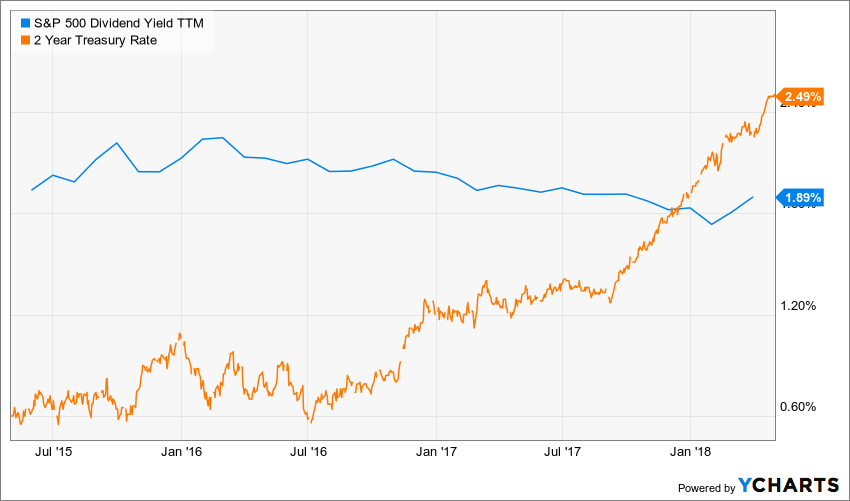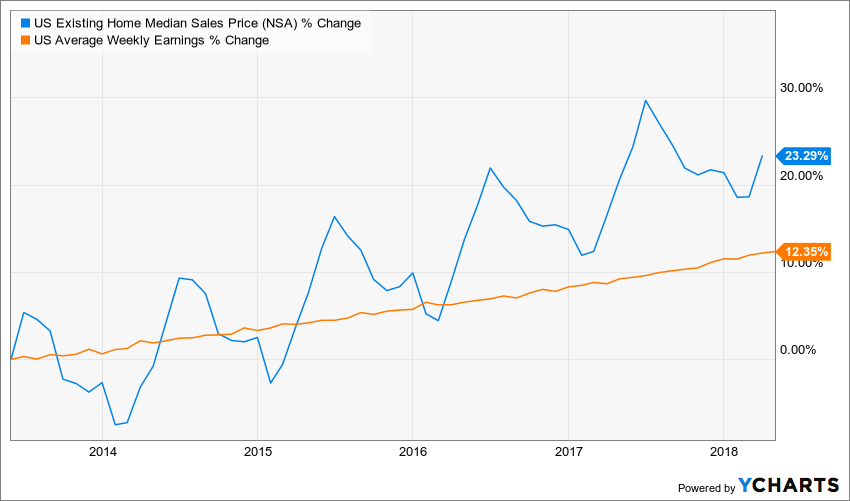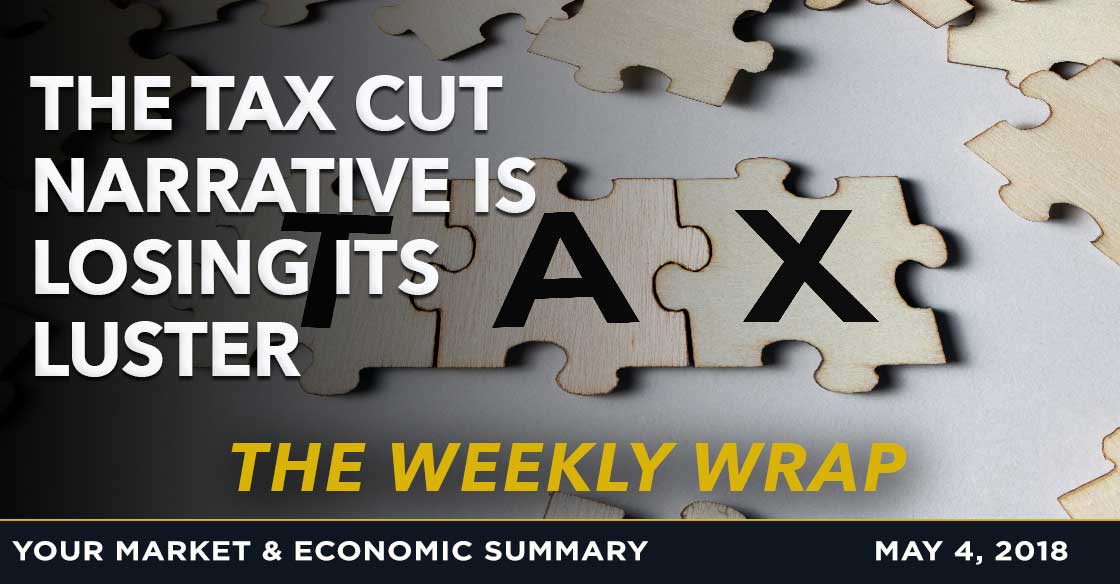MAY 4 WEEKLY WRAP: The Tax Cut Narrative is Losing its Luster
This week we are focused on rising interest rates and a strengthening dollar as the narrative of synchronized global growth fails; rising prices from tariffs, troubles in the oil markets and wage pressures; equity weakness despite earnings as investors become more bearish, fearing this is as good as it can get.
Markets
First, let’s recap the market’s moves for the week. Monday’s close marked the end of the first third of the year with the S&P 500 down -0.5% in the first four months of 2018, the Dow Jones Industrial Average down -1.8% and the Nasdaq 100 up +3.5% with the Russell 2000 small cap laden index up +0.80%. The strongest sector for the first four months was Consumer Discretionary, up +5.4% with the weakest Consumer Staples, down -10.8% – yet another hallmark of a late stage market. Only two other sectors closed the 4-month period in the black, Energy, up +2.9% and Technology, up +2.7%. As we stepped into May, most every major US equity index was below its 50-day moving average, from the Dow (DIA) to S&P 500 mid-cap (IJH) to Russell 1000 (IWB) to Micro-Cap (IWC) to S&P 100 (OEF) and the Total Stock Market (VTI).
As of Friday’s close, the S&P 500 will not have made a new closing high since January 26th and its 50-day moving average is within 66 points (as of Thursday’s close) of closing below the 200-day moving average – the infamous “death cross,” having bounced off of it in an early morning plunge on Thursday. In the last bear market, we saw a death cross on December 21, 2007, which was 73 days after the market had peaked. The S&P 500 dividend yield has declined 36 basis points since February 2016 while the yield on the 2-year Treasury note has increased by 160 basis points – stocks are facing yield competition, TINA has left the building.

Rising Dollar
Wednesday the US Dollar Index (DXY) closed above its 200-day moving average for the first time in nearly a year, ending its seventh-longest streak of closes below that level dating back to 1971. The dollar is still down 6.6% over the past year, but we just may be seeing a turnaround in progress and the world is watching.
Around half of S&P 500 sales come from overseas, which makes a falling dollar a serious tailwind, but the reverse is also the case. Keep in mind too that transactions in US dollars account for almost three times more than those in euro and twenty times more than in yuan. It is the most widely used currency globally and growing in use. When it gets more expensive, it has a profound impact across the globe.
Earnings Fail to Impress
While more than 80% of companies have reported so far this season the average stock in the S&P 500 saw a move of +/-3.5% following the release of their company’s results, according to data from Goldman Sachs, well above the 2-year average of +/- 2.8%. While the results are rather impressive with respect to both top and bottom line results in terms of percent of companies beating expectations, shares are not feeling much love. This week’s AAII sentiment survey found bullish sentiment has fallen from 36.9% to 28.4%. Talk about a case of “What have you done for me lately?” In at least one earnings call this season we learned that analysts must work on not asking “boring” questions concerning such mundane topics as cash burn. Yep, that happened, and it sent Twitter a flutter… so much so that Elon Musk embarked on a tweet filled “guilty with an explanation” response that many have used when pulled over for a speeding ticket.
The sentiment trend has also been negative since the market peaked at close to 60% bullish earlier in the year. We are seeing lower bullish highs on the weeks that sentiment improves followed by weeks with even bigger declines. Investors are increasingly concerned that this is the best it is going to be, particularly when we see the economic data is failing to show accelerating growth as the prevailing narrative assured us we’d see post the tax cuts.
Economy
Let’s review just what the data is telling us about the economy. On Monday, the last day in April we received the Personal Income and Spending Report which includes the Personal Consumption Expenditure deflator, the Federal Reserve’s preferred inflation gauge, which rose by 2.0% year-over-year in March, which is the hottest reading in over a year, well above the post-recession average of 1.4% and above the Federal Reserve’s own year-end forecast of 1.9%. The core rate is 1.9%, which puts the 1.625% Fed funds rate in negative territory on a real basis. We’ve never had an economy in this position so late in the business cycle – that’s right I said never. We’ve got rising inflation with a negative real fed funds rate when we sit at one of the longest expansions in history –I can’t imagine why anyone would be concerned (sarcasm).
Wages and Salaries on a year-over-year basis hit 4.5%, in the higher range of what we’ve seen during this expansion, while Real Personal Income was only 1.5% year-over-year, near the lower end of the spectrum since 2011. The annualized rolling 3-month rate of change in Real PCE Spending dropping to 1.06%, the lowest level since 2013 – not exactly in line with the narrative calling for a post-tax cut boost in consumer spending, but it’s right in line with our expectations here at Tematica given the consumer debt load. The 0.2% gain in wages and salary in March was utterly absorbed by higher prices – explains McDonald’s (MCD) better sales and profits performance now doesn’t it?
We also received significant manufacturing sector sentiment data. First, the Chicago PMI, which has the highest correlation to the ISM manufacturing, missed estimates for the third consecutive month, predicting a significant decline in the ISM Manufacturing PMI. Second, with the reporting on the Dallas Fed’s Manufacturing Index, we have all five regional Fed indices for the manufacturing sector and they reveal that the outlook continues to deteriorate across a wide range of categories. New orders, Shipments and Unfilled Orders have seen particularly painful declines, while Prices Received continuing to accelerate to the upside while the current index for Prices Paid declined. However, over the past year, the current Prices Paid has risen the most of any component in the index, seconded by the Prices Received component. Delivery times reached a new record high as we are seeing further capacity constraints in transportation with surging freight fees. Perhaps most concerning we saw the outlook for capital expenditures take a serious hit, which is decidedly counter to the narrative that the tax cuts would lead to an acceleration in such spending.
Tuesday the ISM Manufacturing report for April came in with the weakest headline reading since last July and the weakest relative to expectations since April 2017. To put that miss in context, the index was at its highest level since 2004 just two months ago, but this month’s report isn’t exactly supportive of an acceleration, which is what the prevailing tax cuts narrative expected. Production saw the biggest decline, falling from 61.0 to 57.2, with employment close behind with a decline to 54.2 from 57.3 to sit at its weakest level in nearly 18-months. Both Production and New Orders, down to 61.2 from 61.9, have declined four months in a row with New Orders at a 9-month low. Backlog Orders reached a 14-year high, while Prices Paid hit the highest level in 7 years – clearly backlog gets addressed with higher prices! The supply chain is under pressure, which is likely to result in higher prices paid by consumers, further eroding the historically weak rate of income growth.
The ISM Non-manufacturing Index was also weaker than the 58 expected, coming in at 56.8. New export orders accelerated, but backlog and employment slowed. The Employment component also saw a fairly large drop this month and is down significantly from its recent peak in January.
The latest data from the Census Bureau also showed the growth in capital goods orders and shipments has slowed. The narrative of post-tax cut capex acceleration is not coming to fruition, as I might add, we predicted. We argued that pre-tax cut cash levels on corporate balance sheets, thanks in part to a festival of debt issuance, was already sufficiently high to support additional capex, if that was desired.
As for the capex that has occurred, well it isn’t exactly getting the job done with productivity rising 0.7% in the first quarter while unit labor costs rose 2.7% – not a recipe for success. Overall this is looking more and more like a late stage market – real domestic final sales have slowed to a 2-year low while core consumer inflation is at a 7-year high and total labor compensation has hit a more than 10-year high. No wonder investors are skeptical.
The less than stellar results aren’t just in the US as Industrial output in the eurozone has contracted now for three consecutive months while Citigroup’s economic surprise index for the region has fallen from a euphoric peak in December to levels not seen since the depths of the EMU 2011 banking crisis. The British economy slowed to a near halt in the first quarter, part thanks to global conditions with part attributable to the Beast from the East, (lived it, don’t want to repeat it).
Strong Employment Driven by Small Biz
The headline print for the ADP Employment Reportfractionally beat expectations for 198k, coming in at 204k, but that modest beat was offset by the March revision to 228k from 241k. The headline number has been at least 200k for six consecutive months, a trend we haven’t seen in nearly four years. However, there were some warning signs with large company hiring getting weaker, and the same was found in the manufacturing and the industrial sector as well as transports and financials. The April strength came primarily from small-business services (less than 50 employees) which rose to a 4-month high and is solely responsible for the modest beat.
Ford truck sales report on Wednesday confirmed this strength in small business.Ford recently announced that it will stop producing most car models in the North American markets, instead focusing on SUVs and trucks, which are higher margin products. In April Ford sold 73,104 F-Series trucks, the best April for the F-Series since 2000 and the fourth best going back to 1996. The year-to-date sales for the F-Series is the third strongest going back to 1996, bested only by sales in 1999 and 2000. Trucks are most often purchased by small businesses and contractors, giving insight into the health of the small business sector.
Oil Prices
Oil prices have been rising due to a number of factors: production cuts by Opec and Russia, the implosion of the Maduro regime in Venezuela and fears that Trump will re-impose further sanctions on Iran which could reduce global supply by 700,000 barrels a day over the next 12-months. On the campaign Trump harshly criticized the 2015 nuclear deal with Iran, calling it the “worst deal ever.” On May 12thPresident Trump will be required to re-endorse the deal and it is looking increasingly unlikely that he will. Then again this is Trump, so predictability is not his strongest trait.
The current accord is the result of around 20 months of negotiations with signatories including the five permanent (and veto carrying) members of the UN Security Council, namely the US, UK, France, China, Russia, Germany and the European Union and of course Iran. Any attempts to change or replace the accords will be time-consuming and will increase geopolitical instability as there is strong support from the other permanent members of the UN Security Council, Germany and the EU to continue the agreement.
In response, Iran recently announced that it will start reporting foreign currency amounts in euros rather than in US dollars, as part of the nation’s efforts to reduce its reliance on the US dollar given the rising political tensions with Washington. The Iranian central bank governor Valiollah Seif stated that the “dollar has no place in our transactions today.” Iran today engages in hardly any trade with the US after decades of economic sanctions. Its most important trading partner is the UAE at 24% of imports and exports with China at 22%, followed by Turkey, India and the EU which accounts for about 6%.
The effect of rising energy costs on a slowing global economy ought not be ignored. For example, during the oil price decline in 2015 and 2016, consumers in the US, Europe, China and India effectively benefited from a $1.6 trillion windfall. In contrast, this year they face a $800 billion headwind. From a consumer perspective, we are seeing gas prices close in on $3 per gallon, something last seen four years ago. We see this as another factor in addition to rising credit costs that will crimp discretionary consumer spending at the margin.
And that brings me to my final comment for the week is all about rates and debt levels. During the last cycle, the outstanding nonfinancial debt load peaked at $27 trillion. Today it has reached $47 trillion with roughly one-fifth of that rolling over annually. I’m less concerned about the shape of the curve during any given month than I am with what rising rates are going to mean for debt-servicing capacity, defaults and delinquencies. For example, mortgage rates have risen more than 50 basis points this year, with the 30-year fixed rate reaching 4.8%, the highest it’s been in four years.
Over the past five years, the median sales price for existing home sales has risen 23.3% while US average weekly earnings has increased just 12.4%, making that home less and less obtainable. Adding to the pain, new homes are becoming less affordable as inflation on construction materials accelerates and builders pass on the higher costs to buyers, including new tariffs to be had on building materials such as lumber and aluminum.

To wrap it all up, rising rates and a strengthening dollar are exacerbating and being exacerbated by the failure of the synchronized global growth acceleration narrative. I have no idea how I pulled out that sentence on a Friday afternoon. Rising tension around trade wars and now tensions with Iran are just adding to the upward price pressures as is the employment situation. Investors are taking it all in and wondering, what is the catalyst for my happily ever after in 2018.

